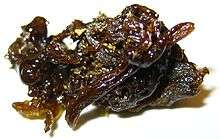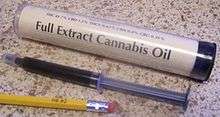Hash oil
| Hash oil | |
|---|---|
 One form of hash oil | |
| Product name | Hash oil |
| Source plant(s) | Cannabis sativa, Cannabis indica, Cannabis ruderalis (rarely) |
| Part(s) of plant | all |
| Geographic origin |
United States Afghanistan |
| Active ingredients | Tetrahydrocannabinol, cannabidiol, cannabinol, tetrahydrocannabivarin |
| Legal status |
|
| Part of a series on |
| Cannabis |
|---|
 |
|
Chemistry |
|
Economics |
|
Regional
|
|
Hash oil or cannabis oil is an oleoresin obtained by the extraction of cannabis or hashish. It is a concentrated form of the plant containing many of its resins and terpenes – in particular, tetrahydrocannabinol (THC), cannabidiol (CBD), and other cannabinoids. There are a variety of extraction methods, but most involve a solvent such as butane or ethanol. Hash oil is usually consumed by smoking, vaporizing or eating but sometimes other methods are employed. Hash oil is sometimes sold in cartridges to be used with pen vaporizers.
Hash oil is an extracted cannabis product that may utilize any part of the plant. Ideally, the final product will not contain any residual traces of solvents. It is generally thought to be indistinct from traditional hashish according to the 1961 UN Single Convention on Narcotic Drugs (Schedule I and IV) as it is "the separated resin, whether crude or purified, obtained from the cannabis plant".
Preparations of hash oil may be solid or colloidal depending on both production method and temperature and are usually referred to by their appearance or characteristics. Range of color, most commonly golden to light brown, can vary from transparent to yellow, tan, to black.
Cannabis dispensaries in California have reported about 40% of their sales are from cannabis oils.[1]
Composition
The tetrahydrocannabinol (THC) content of hash oil varies tremendously, since the manufacturers use a varying assortment of marijuana plants and preparation techniques. Dealers sometimes cut hash oils with other oils.[2][3]
Hash oils seized in the 1970s had a THC contents ranging from 10 to 30%. The oil available on the U.S. West Coast in 1974 averaged about 15% THC.[2] Samples seized across the United States by the Drug Enforcement Administration over an 18-year period (1980–1997) showed that THC content in hashish and hashish oil averaging 12.9% and 17.4%, respectively, did not show an increase over time.[4] The highest THC concentrations measured were 52.9% in hashish and 47.0% in hash oil.[5] Hash oils in use in the 2010s had THC concentrations as high as 90%[6][7] and other products achieving higher concentrations [8]
The following compounds were found in naphtha extracts of Bedrocan Dutch medical cannabis:[9]
- Cannabinoids: THC (~ 30%) and THCA (~ 60%).
- Monoterpenes (~ 5%): β-pinene, myrcene, β-phellandrene, cis-ocimene, terpinolene, and terpineol.
- Sesquiterpenes (~ 5%): β-caryophyllene, humulene, δ-guaiene, γ-cadinene, eudesma-3,7(11)-diene, and elemene.
The form of the extract varies depending on the process used; it may be liquid, a clear amber solid (called “shatter"), a sticky semisolid substance (called "wax"), or a brittle honeycombed solid (called "honeycomb wax").[10]
History
Traditional ice-water separated hashish production utilizes water as a solvent, though this method still leaves much residual plant matter and is therefore poorly suited for full vaporization.
Project MKUltra, the Central Intelligence Agency project investigating interrogations utilizing narcotics, involved the use of liquid cannabis[11] as a truth serum.[12] The details of these preparations were likely destroyed with other documentation from the project.
So called "butane honey oil" was available briefly in the 1970's.[13][1] This product was made in Kabul, Afghanistan and smuggled into the United States by The Brotherhood of Eternal Love. Production is thought to have ceased when the facility was destroyed in an explosion.
Gold described the use of alcohol and activated charcoal in honey oil production by 1989,[14] and Michael Starks further detailed procedures and various solvents by 1990.[15]
Colorado and Washington began licensing hash oil extraction operations in 2014.[1]
Use

Hash oil is consumed usually by smoking, ingestion, or vaporization.[10] Smoking or vaporizing hash oil is known colloquially as "dabbing",[10] from the English verb to daub (Dutch dabben, French dauber), "to smear with something adhesive".[16] Dabbing devices include special kinds of water pipes ("oil rigs"), and vaporizers similar in design to electronic cigarettes.[10] Oil rigs include a glass water pipe and a hollow tube (called a "nail"), with an indentation on the side which is sometimes covered with a dome.[10] The pipe is often heated with a blowtorch rather than a cigarette lighter.[10]
The oil can also be sold in pre-filled atomizer cartridges. The cartridge is used by connecting it to a battery and inhaling the vaporized oil from the cartridge's mouthpiece.[17]
Production
Hash oil is produced by solvent extraction (maceration, infusion or percolation) of marijuana or hashish. After filtering and evaporating the solvent, a sticky resinous liquid with a strong herbal odor (remarkably different from the peculiar odor of hemp) remains.[2][18]
Fresh, undried plant material is less suited for hash oil production, because much THC and CBD will be present in their carboxylic acid forms (THCA and CBDA), which may not be highly soluble in some solvents.[2] The acids are decarboxylated during drying and heating (smoking).
A wide variety of solvents can be used for extraction, such as chloroform, dichloromethane, petroleum ether, naphtha, benzene, butane, methanol, ethanol, isopropanol, and olive oil.[2][9] Currently, resinoids are often obtained by extraction with supercritical carbon dioxide. The alcohols extract undesirable water-soluble substances such as chlorophylls and sugars (which can be removed later by washing with water). Non-polar solvents such as benzene, chloroform and petroleum ether will not extract the water-soluble constituents of marijuana or hashish while still producing hash oil. In general, non-polar cannabis extracts taste much better than polar extracts. Alkali washing further improves the odor and taste.

The oil may be further refined by 1) alkali washing, or removing the heavy aromatic carboxylic acids with antibiotic properties, which may cause heartburn, gallbladder and pancreas irritation, and resistance to hemp antibiotics; 2) conversion of CBD to THC. Process 1) consists of dissolving the oil in a nonpolar solvent such as petroleum ether, repeatedly washing (saponifying) with a base such as sodium carbonate solution until the yellow residue disappears from the watery phase, decanting, and washing with water to remove the base and the saponified components (and evaporating the solvents). This process reduces the oil yield, but the resulting oil is less acidic, easier digestible and much more potent (almost pure THC). Process 2) consists of dissolving the oil in a suitable solvent such as absolute ethanol containing 0.05% hydrochloric acid, and boiling the mixture for 2 hours.[19]
One pound of marijuana yields from 1/5 to 1/10 of a pound of hash oil.[18] The oil may retain considerable residual solvent: oil extracted with longer-chain volatile hydrocarbons (such as naphtha) is less viscous (thinner) than oil extracted with short-chain hydrocarbons (such as butane).[9]
Colored impurities from the oil can be removed by adding activated charcoal to about one third to one half the weight or volume of the solvent containing the dissolved oil, mixing well, filtering, and evaporating the solvent.[2] When decolorizing fatty oils, oil retention can be up to 50 wt % on bleaching earths and nearly 100 wt % on activated charcoal.[20]
Legality
Possession or manufacture of cannabis and cannabis extracts is illegal in most jurisdictions. People caught with small amounts of extracts can face extremely harsh prison sentences. As of 2017 in some regions of the United States mandatory minimums of a year in jail still exist. However, it is widely produced in states where cannabis has been legalized.[1]
Safety
Use
As of 2015 the health effects of using hash oil were poorly documented. Cannabis extracts have less plant matter and create less harmful smoke, however, trace amounts of impurities are not generally regarded as safe (GRAS).[10]
Production
Most of the solvents employed vaporize quickly and are flammable, making the extraction process dangerous. Several explosion and fire incidents related to hash oil manufacturing attempts in homes have been reported.[18]
Solvents used to extract THC are flammable or combustible and have resulted in explosions, fires, severe injuries, and deaths.[21][22][7][23][24][25]
Handling
The LD50 for THC (Delta 9 Tetrahydrocannabinol) is not precisely known. Hash oil can contain up to 80% THC though up to 99% with other methods of extraction. While health issues of the lungs may be exacerbated by use of hash oil, it is not known to cause side effects not already found in other preparations of cannabis.
Storage
When exposed to air, warmth and light (especially without antioxidants), the oil loses its taste and psychoactivity due to aging. Cannabinoid carboxylic acids (THCA, CBDA, and maybe others) have an antibiotic effect on gram-positive bacteria such as (penicillin-resistant) Staphylococcus aureus, but gram-negative bacteria such as Escherichia coli are unaffected.[26]
See also
Literature
- Ed Rosenthal, Beyond Buds: Marijuana Extracts, 2014.
References
- 1 2 3 4 Lewis, Amanda Chicago (30 April 2015). "Wax Is Weed's Next Big Thing And No One Knows If It's Safe". Buzzfeed. Retrieved 3 June 2018.
- 1 2 3 4 5 6 Michael Starks (1993), Marijuana Chemistry: Genetics, Processing, Potency (2nd ed.), Ronin, pp. 111–126, ISBN 9780914171393
- ↑ "Cannabis: Overview", World Drug Report (PDF), United Nations Publications, 2014
- ↑ Marilyn A. Huestis; Michael L. Smith (2007), "Human Cannabinoid Pharmacokinetics and Interpretation of Cannabinoid Concentrations in Biological Fluids and Tissues", in Mahmoud A. ElSohly, Marijuana and the Cannabinoids, Humana Press, pp. 205–235
- ↑ Rudolf Brenneisen (2007), "Chemistry and Analysis of Phytocannabinoids and Other Cannabis Constituents", in Mahmoud A. ElSohly, Marijuana and the Cannabinoids, Humana Press, pp. 17–49
- ↑ Gloss, D (October 2015). "An Overview of Products and Bias in Research". Neurotherapeutics : the journal of the American Society for Experimental NeuroTherapeutics. 12 (4): 731–4. doi:10.1007/s13311-015-0370-x. PMC 4604179. PMID 26202343.
- 1 2 "Safety with hash oil". Colorado Marijuana. Retrieved 17 November 2016.
- ↑ Valerie Vande Panne (21 December 2013). "Hey Buddy, Wanna Dab? Inside The Mainstream Explosion of Cannabis Concentrates". The Daily Beast. Retrieved 3 December 2016.
- 1 2 3 Luigi L. Romano; Arno Hazekamp (2013), "Cannabis Oil: chemical evaluation of an upcoming cannabis-based medicine" (PDF), Cannabinoids, 1 (1): 1–11
- 1 2 3 4 5 6 7 Stogner, JM; Miller, BL (July 2015). "Assessing the Dangers of "Dabbing": Mere Marijuana or Harmful New Trend?" (PDF). Pediatrics. 136 (1): 1–3. doi:10.1542/peds.2015-0454. PMID 26077476.
- ↑ Kamiya, Gary (1 April 2016). "When the CIA ran a LSD sex-house in San Francisco". San Francisco Chronicle. Retrieved 3 June 2018.
- ↑ Bennett, Patrick. "Where Did Dabs Come From? A History of Cannabis Extracts". Leafly. Retrieved 3 June 2018.
- ↑ Bienenstock, David (2016). How to Smoke Pot (Properly): A Highbrow Guide to Getting High (1st ed.). Plume. ISBN 978-0147517081. Retrieved 3 June 2018.
- ↑ Gold, D. (1989) [1973]. Cannabis Alchemy: The Art of Modern Hashmaking (2nd ed.).
- ↑ Starks, Michael (1990) [1977]. Marijuana Chemistry: Genetics Processing and Potency (2nd ed.).
- ↑ Samuel Johnson (1785), "daub", A Dictionary of the English Language, 1 (6th ed.), p. 541
- ↑ Lewis, Amanda. "Are Weed Vape Pens Safe?". Rolling Stone. Retrieved 5 July 2018.
- 1 2 3 Alison Hallett (2013-02-20), "Hash Oil is Blowing Up Across the U.S. - Literally", Wired
- ↑ Yechiel Gaoni; Raphael Mechoulam (1964), "Isolation, Structure, and Partial Synthesis of an Active Constituent of Hashish", Journal of the American Chemical Society, 86 (8): 1646–1647, doi:10.1021/ja01062a046
- ↑ Alfred Thomas (2007), "Fats and Fatty Oils", Ullmann's Encyclopedia of Industrial Chemistry (7th ed.), Wiley, p. 31
- ↑ "Dangers of Butane Hash Oil Labs Cited as Five are Charged". US Department of Justice. March 30, 2016.
- ↑ "Butane Hash Oil Extraction Hazards Issued" (PDF). New Jersey Department of Community Affairs. January 2013.
- ↑ "Marijuana Butane Honey Oil Extraction on the Rise". Los Angeles County Fire Department. 19 June 2014.
- ↑ Romanowski, KS; Barsun, A; Kwan, P; Teo, EH; Palmieri, TL; Sen, S; Maguina, P; Greenhalgh, DG (30 March 2016). "Butane Hash Oil Burns: A 7-Year Perspective on a Growing Problem". Journal of Burn Care & Research. doi:10.1097/BCR.0000000000000334. PMID 27058582.
- ↑ Crawford, Angus (5 August 2016). "Rise in UK explosions linked to super-strength cannabis" – via www.bbc.co.uk.
- ↑ Jan Kabelik (1955), "Hemp as a medicament" (PDF), Acta Univ. Olomuc., 6, archived from the original (PDF) on 2015-07-01